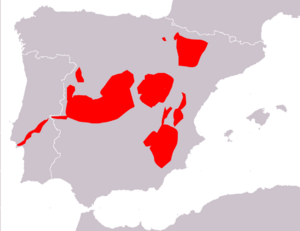Cabrera's vole facts for kids
Quick facts for kids Cabrera's vole |
|
|---|---|
| Conservation status | |
| Scientific classification | |
| Genus: |
Microtus
|
| Species: |
cabrerae
|
 |
|
| Approximate distribution of Cabrera's vole | |
The Cabrera's vole (Microtus cabrerae) is a type of vole that lives in Spain and Portugal. It was named after Ángel Cabrera, a scientist who studied mammals. He worked at a museum in Madrid, Spain.
This vole is the only living member of a special group called Iberomys. Scientists have also found two fossil types of this vole. One of these, M. brecciensis, might be the direct ancestor of the living species.
Contents
What Does a Cabrera's Vole Look Like?
The Cabrera's vole is one of the biggest voles in its family, Microtus. Its body is about 10 to 14 cm (3.9 to 5.5 in) long. Its tail is about 3 to 5 cm (1.2 to 2.0 in) long.
Adult voles weigh between 30 and 78 g (1.1 and 2.8 oz). This can be up to five times heavier than other voles found in Spain and Portugal. They have long, thick fur. Most of their body is brownish-olive, and their belly is yellowish.
Their special guard hairs are very long. They can stick out as far as 1 cm (0.39 in) from the body. This is longer than in any other Microtus species. Inside their body, they have a longer caecum (a part of the digestive system). This might be because of their special diet. Otherwise, the Cabrera's vole looks like a typical vole. It has a round head, small ears, and a short tail compared to its body.
Where Do Cabrera's Voles Live?
Cabrera's voles are only found in certain areas of Spain and Portugal. You can find them on the southern and western sides of the mountains in these countries. Their range goes from the Pyrenees mountains all the way to southern Portugal.
These voles live in grassy areas and on farmland. They also live in clearings within oak forests. They usually live in small groups that are quite separate from each other. These groups are often found near water.
A long time ago, about 2000 years ago, these voles lived in many more places. They even used to live in southern France. Today, there are no different types (subspecies) of Cabrera's vole.
How Do Cabrera's Voles Live?
Cabrera's voles prefer grassy areas where the soil is very moist. They often live near streams or ponds. However, they usually don't stay in one spot for more than four months. In winter, they tend to move to areas with more rushes and sedges (types of grass-like plants).
What Do They Eat?
These voles are herbivores, meaning they only eat plants. A large part of their diet, up to 58%, is made up of different kinds of grasses.
Daily Life and Breeding
Cabrera's voles are active during the day. They dig their own burrows to live in.
They can have babies throughout the year. However, they tend to breed more often in winter than in summer. This is probably because there is more green grass available in winter. It's unusual for voles, but Cabrera's voles often stay with one partner. Though, some males might mate with more than one female.
A mother vole is pregnant for 23 or 24 days. She usually gives birth to a litter of three to five young voles. She builds a nest five or six days before her babies are born.
Baby Voles
When baby voles are born, they don't have hair and cannot see. Their ears are closed, and their toes are still joined together. They are very tiny, about 4 mm (0.16 in) long, and weigh about 3.5 g (0.12 oz).
By five days old, their hair has fully grown. They can start walking by seven or eight days old. Their eyes open fully when they are about eleven days old. Soon after, they begin to explore their nest and try solid food. They stop drinking their mother's milk completely by 15 days old.


